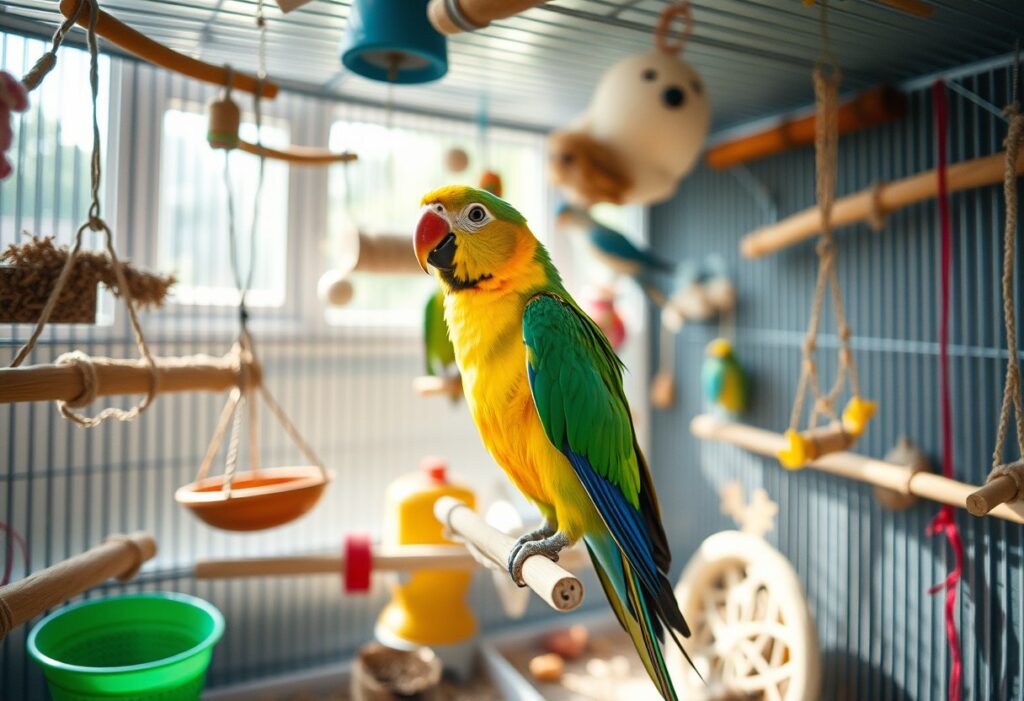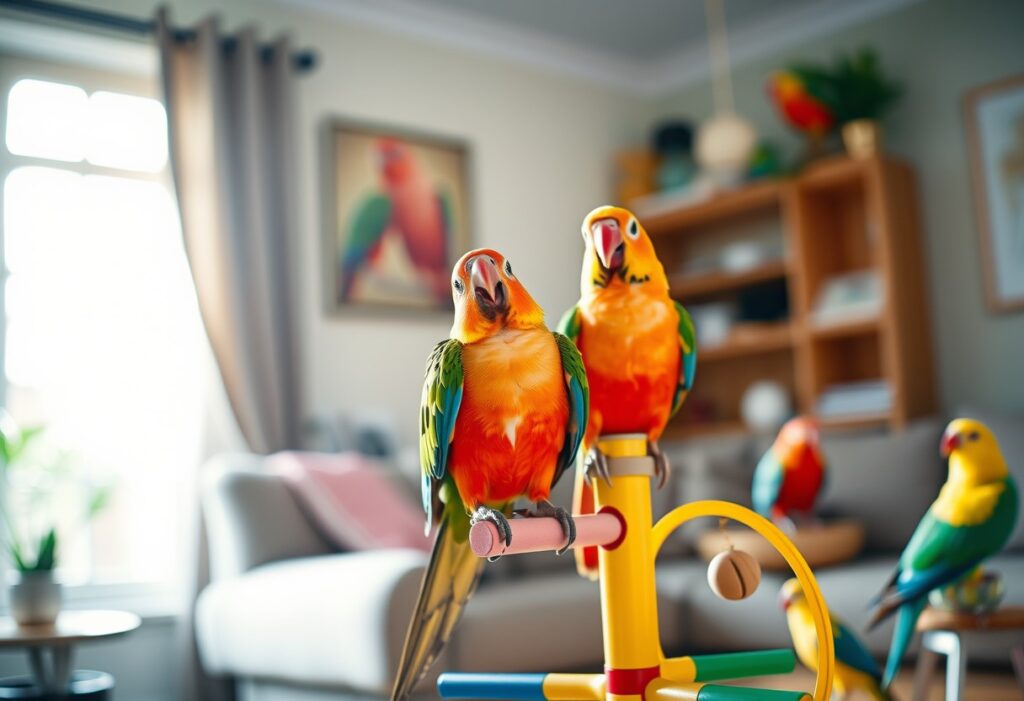Most pet bird owners may overlook the significance of enrichment in their birds’ lives, yet it plays a critical role in promoting healthy and stimulating behavior. By understanding how various forms of enrichment—like toys, puzzles, and social interaction—can impact your bird’s mental and physical well-being, you can create an environment that reduces stress and mitigates harmful behaviors. Recognizing the importance of enrichment not only enhances your bird’s quality of life but also fosters a stronger bond between you and your feathered friend.
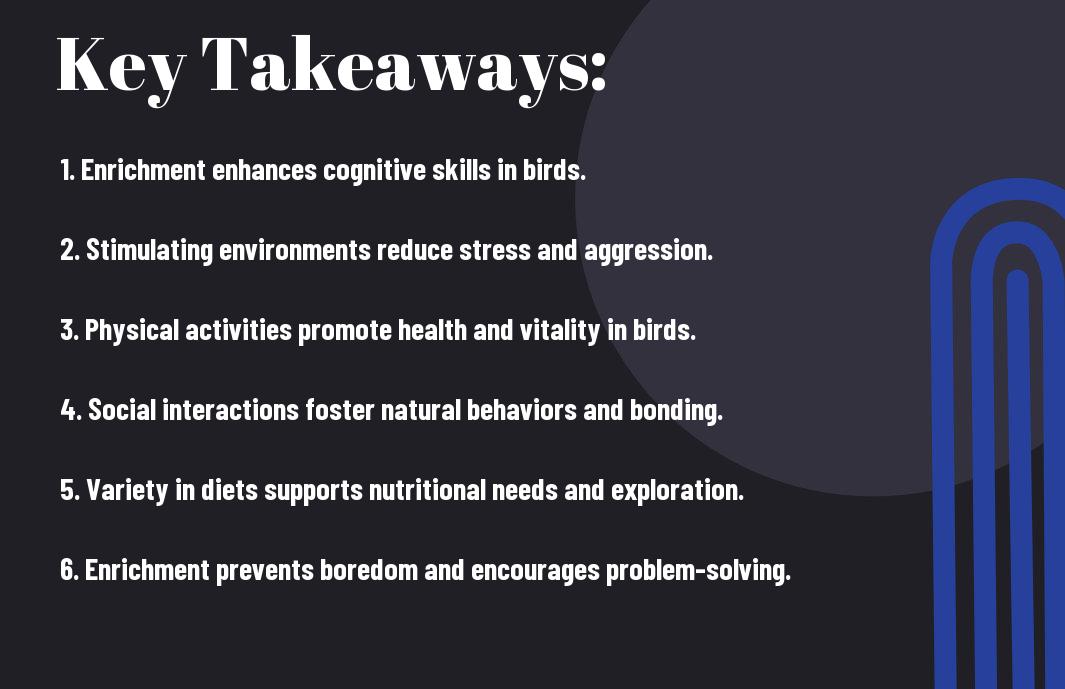
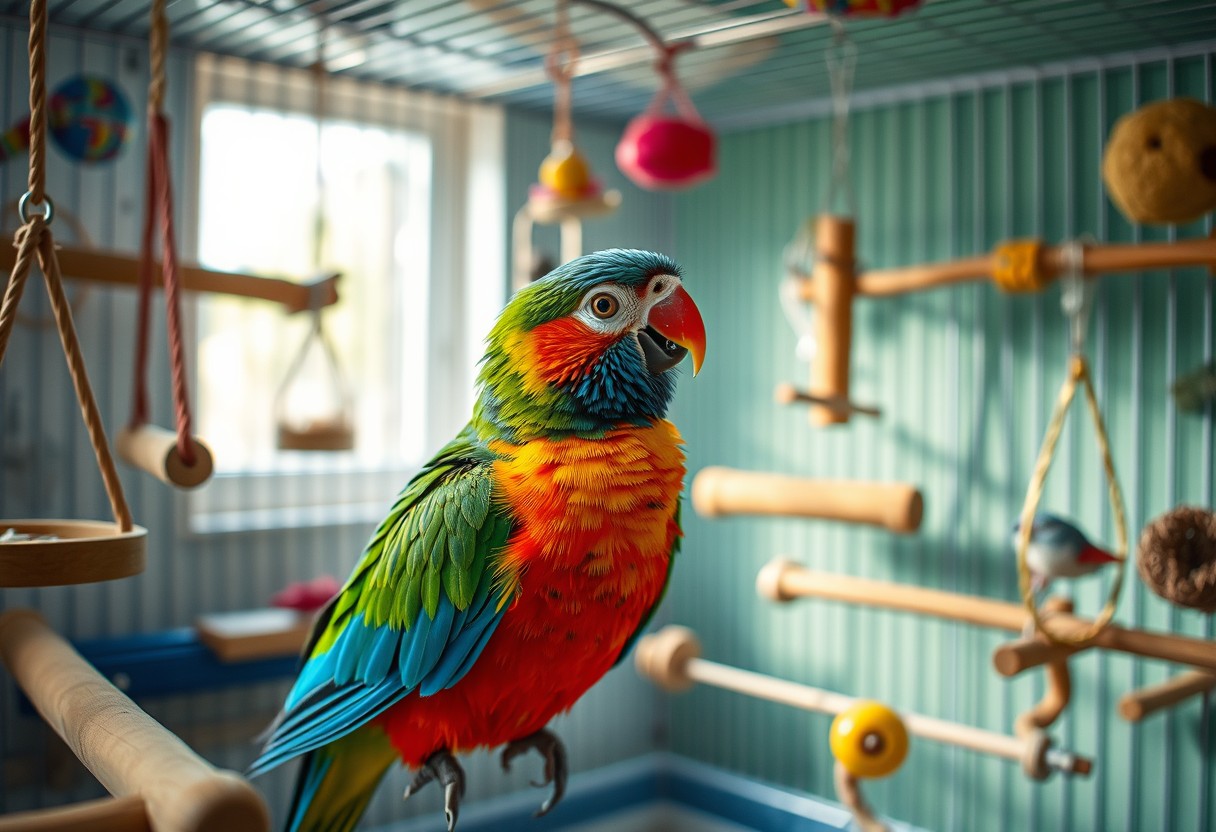
Understanding Enrichment
The role of enrichment in bird behavior cannot be overstated, as it encapsulates the various methods used to enhance the environments of birds, thereby positively impacting their mental and physical well-being. Enrichment offers birds the opportunity to engage in natural behaviors that are often suppressed in captivity, allowing them to experience diverse stimuli that promote curiosity and all-around health.
Definition of Enrichment
With enriched environments, birds are provided with various forms of stimulation that can include physical, social, and sensory elements. This concept of enrichment is crucial for their overall well-being, as it addresses the natural instincts and behaviors that birds would engage in if they were in the wild. Enrichment can take various forms, such as providing perches, toys, or even naturalistic habitats that encourage exploration and play.
Types of Enrichment
With a deeper understanding of enrichment, you can begin to categorize it into different types that cater to various aspects of your bird’s behavior. The main categories include:
- Physical enrichment: Incorporating different structures such as perches, swings, and climbing opportunities.
- Cognitive enrichment: Introducing puzzles and foraging activities that challenge your bird’s intelligence.
- Social enrichment: Facilitating interactions with other birds or humans to satisfy social needs.
- Dietary enrichment: Offering varied foods and feeding methods to stimulate interest in mealtimes.
- Environmental enrichment: Modifying the living space with various textures and hiding spots.
After incorporating these strategies into your bird’s life, you will likely see improvements in behavior, health, and overall happiness.
| Type of Enrichment | Description |
| Physical | Structures like perches and swings. |
| Cognitive | Puzzles that promote problem-solving. |
| Social | Interactions with other birds or humans. |
| Dietary | Variety in foods and feeding methods. |
| Environmental | Diverse textures and hiding spots. |
Enrichment serves as a multifaceted approach to caring for your feathered friends. It’s not just about providing food and water; it’s about creating an environment that closely resembles their natural habitat. This leads to enhanced well-being and encourages natural behaviors, providing a better quality of life.
- Play opportunities: Engaging your bird with toys and activities to keep them active.
- Variety in surroundings: Changing up the environment periodically to stimulate interest.
- Sound enrichment: Introducing sounds from nature via recordings.
- Visual stimulation: Using bright colors and varied shapes for more engaging environments.
- Routine changes: Altering the daily schedule to boost their curiosity.
After understanding the various forms of enrichment, you can implement these methods to create a more dynamic space for your birds.
Importance of Environmental Complexity
An enriched environment is crucial to preventing boredom and stress in birds. Environments that lack complexity can lead to a range of behavioral issues, such as feather plucking or self-destructive behaviors. Providing a multifaceted habitat encourages natural behaviors like foraging, socializing, and exercising, contributing to a bird’s physical and mental health.
This emphasis on environmental complexity is vital for your bird’s happiness and well-being. When you incorporate various elements into their habitat, you are not just improving their quality of life but also reducing the risk of behavioral problems that can arise from a lack of stimulation. Do not forget, an engaged bird is a happy bird, and they thrive best in settings that stimulate their instincts.
Behavioral Impacts of Enrichment
Now, the implementation of environmental enrichment can significantly influence the behavior of birds in both captive and wild settings. By providing various forms of stimulation—ranging from interactive toys to naturalistic living conditions—you can encourage more complex and natural behaviors. This enrichment is crucial for maintaining your birds’ mental health and social well-being.
Social Interaction
One of the primary behavioral impacts of enrichment is enhanced social interaction. When you offer a stimulating environment, birds are more likely to engage with each other, fostering social bonds. Enhanced social interaction can lead to reduced stress and improved overall well-being, as birds that engage positively with others generally display more vibrant and confident behaviors.
Moreover, enriching your birds’ environment encourages a hierarchy of social structures to develop. You may observe them displaying behaviors such as grooming, playing, or vocalizing more frequently, which are critical for their social development. These interactions not only satisfy their innate social needs but also contribute to learning important skills through observation and imitation of their peers.
Problem-Solving Skills
Impacts of enrichment extend to the development of your birds’ problem-solving skills. Various enrichment activities compel birds to explore their environment, manipulate objects, and strategize to gain rewards such as food or other positive stimuli. This kind of mental exercise not only enhances cognitive skills but also keeps their minds active and engaged, reducing risks of boredom-induced behaviors.
Skills gained from enrichment can vary significantly among different species and individuals. Some birds may show remarkable ingenuity in overcoming challenges, while others may require more guidance to engage effectively with enrichment tools. This process of problem-solving fosters a sense of achievement and mastery in your birds, ultimately leading to a happier and healthier life.
Foraging Behavior
On the subject of foraging behavior, providing enrichment that simulates natural foraging conditions can drastically improve your birds’ natural instincts. When you place food in varying locations or hide it within more complex structures, it encourages your birds to engage in foraging, akin to what they would do in the wild. They not only enjoy this activity but also benefit from the mental exercise and physical movement it provides.
You might notice that birds that have access to enriching foraging activities display greater enthusiasm and are less likely to develop habits like feather-plucking or excessive vocalization due to boredom. Additionally, foraging mimics their natural behavior, thereby reducing anxiety and improving their mood. Such enriched conditions not only keep your birds stimulated but also enhance their overall quality of life.
A well-structured foraging system can promote greater physical activity and allow your birds to experience a sense of achievement. When your birds successfully find food, it serves as a rewarding experience, reinforcing their natural instincts. Ultimately, you are providing a more enriched life that aligns closely with their natural behaviors, translating to positive health outcomes and vitality.
Enrichment Strategies for Bird Care
Many bird owners may underestimate the importance of enrichment in their feathered companions’ lives. Enrichment strategies are imperative for enhancing your bird’s physical and mental well-being. By incorporating various forms of enrichment, you not only improve their quality of life but also encourage natural behaviors that stimulate your bird’s brain. These strategies can vary from providing physical challenges to creating a more interactive environment. Understanding the different types of enrichment available allows you to tailor your approach to suit your bird’s specific needs.
Physical Enrichment
Careful consideration of physical enrichment is vital. This includes providing your bird with toys that challenge their agility and encourage movement, such as swings, ladders, and foraging devices. Interactive climbing spaces or bird-safe branches can ignite your bird’s natural instincts to explore and perch. Rotating toys regularly can keep your bird from getting bored and can also stimulate problem-solving skills as they engage with new items.
Additionally, creating a safe and structured space for your bird to exercise is crucial. You should incorporate platforms at different heights and varying textures to simulate their natural habitat, allowing for a more engaging experience. Having a variety of perches and enrichment toys available can help minimize stress and prevent the development of behavioral issues caused by boredom or inactivity.
Sensory Enrichment
Enrichment plays a critical role in providing sensory stimulation through various auditory, visual, and tactile experiences. You can enhance your bird’s environment by introducing unique toys with different colors, textures, and sounds. Items such as bells, crinkle toys, or mirrors can provide auditory and visual stimulation that can keep your birds entertained for hours. For tactile enrichment, offering non-toxic, bird-safe materials—such as shredded paper or safe natural fibers—can engage their natural instincts to shred and explore.
Plus, consider incorporating natural elements such as live plants or safe branches. The movement or rustle of leaves can enhance your bird’s environment, simulating the sensation of being in a natural habitat. This approach not only adds visual interest but also encourages exploration and foraging behaviors. Remember that sensory enrichment is not just about providing materials but also creating an engaging, interactive environment that stimulates your bird’s curiosity.
Social Enrichment
Careful attention to social enrichment can significantly affect your bird’s mental health and overall well-being. Birds are social creatures that thrive on interaction, both with other birds and with their human companions. If you have the resources, introducing a companion bird can lead to improved behavioral health as they engage in social activities and develop bonds. Even if you’re a single-bird household, interacting with your feathered friend regularly—through talking, training, or play—can satisfy their social needs effectively.
This bond not only provides your bird with companionship but also helps them practice communication skills, which are crucial for their emotional health. Always be mindful of your bird’s social nature and gauge their comfort level with interactions to ensure a positive experience. Ultimately, social enrichment is about understanding your bird’s needs for companionship and communication, encouraging a healthier lifestyle for them.
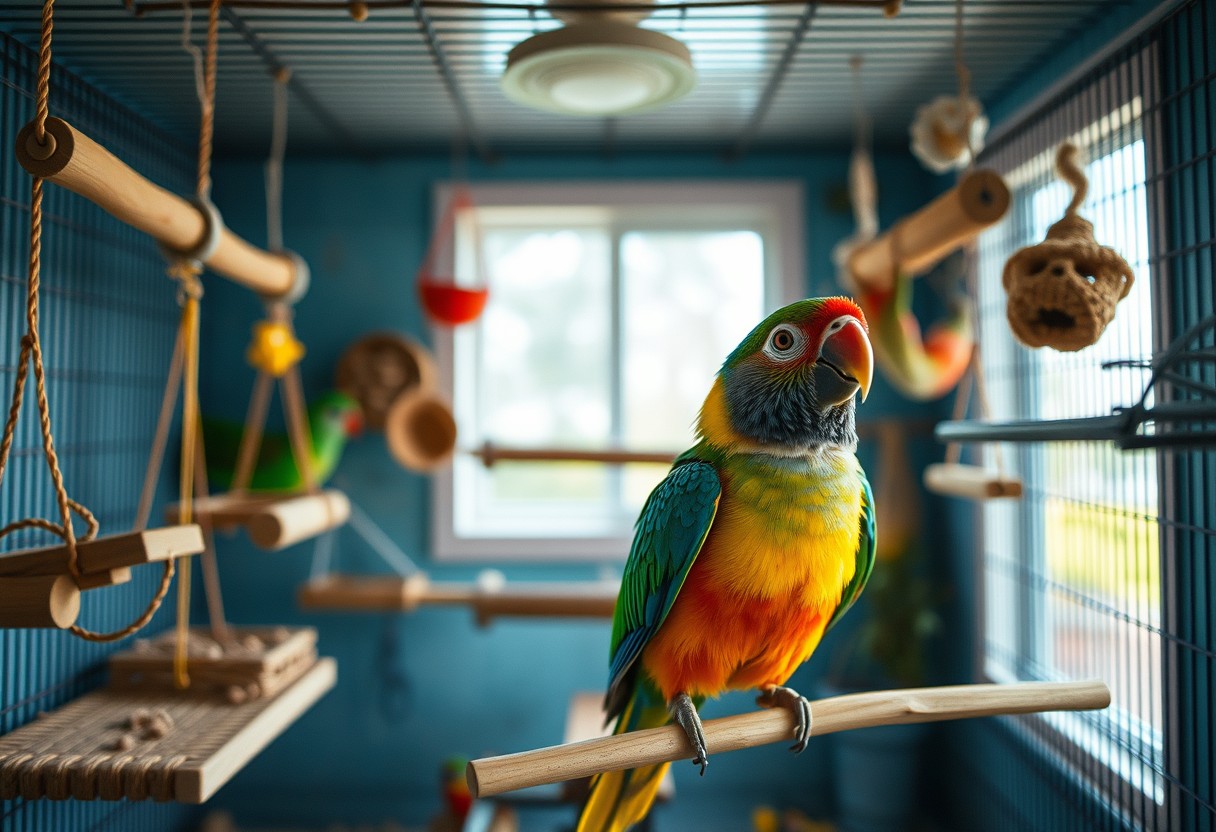
Assessing the Effectiveness of Enrichment
Once again, the implementation of enrichment in the lives of birds requires careful assessment to ensure that it meets their behavioral and psychological needs. By evaluating the outcomes of enrichment, you can determine which activities or resources yield positive impacts and which may need adjustments. It is vital to recognize that enrichment is not a one-size-fits-all solution; every bird species and individual has unique requirements. Observing them closely can provide crucial insights into how effective your enrichment efforts are in fostering natural behaviors and improving their overall quality of life.
Behavioral Observations
An effective way to gauge how well enrichment is working is through thorough behavioral observations. You should take note of the birds’ interactions with the enrichment items. Are they engaging with toys, exploring new environments, or displaying vital behaviors like foraging and socializing? By documenting these behaviors over time, you can better understand whether your current choices are stimulating their natural instincts or simply collecting dust in the corner of their space. Pay attention to any changes in their activity levels, vocalizations, and even nesting behaviors, as these can all indicate the success of your enrichment strategies.
Health and Well-being Indicators
Observations of your birds’ physical health and overall well-being are equally important when assessing enrichment. Consider factors such as feather condition, body weight, and general activity level. Frequent engagement with enrichment items should lead to a more active lifestyle, ultimately reflected in healthier birds. Additionally, you should be aware of any signs of stress or aggression, as negative behaviors can indicate that your enrichment may not be suitable for that particular bird or situation.
This evaluation of health and well-being should encompass both psychological and physiological aspects. For example, if your birds exhibit signs of stress, such as excessive preening or lethargy, it might be time to reassess your enrichment strategies. Likewise, if your birds are thriving, displaying vibrant plumage, and maintaining a healthy body weight, you can be confident that your enrichment activities are positively contributing to their overall health.
Long-term Benefits
On a broader scale, it’s vital to consider the long-term benefits of enrichment for your birds. Continuous assessment will reveal whether your efforts are enhancing their overall quality of life and supporting their natural behaviors over time. A successful enrichment plan not only provides immediate stimulation but can also foster long-lasting changes in their behavioral patterns and emotional health. You should monitor whether these benefits are sustained through consistent engagement and interaction with their environment.
It is crucial to remain flexible and adaptable in your approach. As you gather data on the long-term effects of your enrichment strategies, you may discover that certain activities resonate more with your birds than others. Ensure that you are regularly updating your enrichment offerings to match their interests and needs, thus fostering a dynamic environment where they can thrive. By staying aware of the long-term benefits, you can significantly contribute to their happiness and longevity in your care.
Final Words
So, as you investigate deeper into the fascinating world of avian behavior, it’s crucial to recognize the significant role that enrichment plays in promoting the overall well-being of birds. You’re not just observers of these remarkable creatures; you’re also catalysts for their mental and physical health. By providing a variety of stimulating environments, toys, and interactive activities, you can enhance their quality of life, allowing them to express their natural behaviors and instincts. This proactive approach transforms your interactions, fostering a genuine bond with your feathered friends while ensuring they thrive in your care.
Moreover, understanding the importance of enrichment empowers you to create a more fulfilling habitat for your birds. By considering their individual needs, preferences, and natural behaviors, you can tailor their surroundings to encourage exploration and learning. In doing so, you contribute to their happiness and longevity. Recall, an enriched environment not only promotes better behavior but also reduces stress and boredom, ultimately leading to a healthier and more vibrant avian companion. Embrace this knowledge, and take your avian care practices to new heights!
FAQ
Q: What is the role of environmental enrichment in bird behavior?
A: Environmental enrichment plays a crucial role in enhancing the psychological and physical well-being of birds. It includes the addition of stimulating elements to their habitat, such as toys, varied perches, foraging opportunities, and social interaction. Enrichment helps to reduce boredom and stress, encouraging more natural behaviors such as foraging, exploring, and socializing. This leads to improved mental stimulation and can prevent behavioral issues often associated with confinement, such as feather plucking or excessive vocalization.
Q: How does enrichment affect the social behavior of birds?
A: Enrichment positively influences the social behavior of birds by providing opportunities for interaction with other birds or species, and creating a more dynamic and engaging environment. Social interactions can reduce anxiety and aggression as birds establish and reinforce social hierarchies. The introduction of new stimuli, such as mirrors or toys that require collaboration, encourages cooperative behaviors and increases overall social engagement, which is crucial for species that thrive in flocks or social groups.
Q: What types of enrichment are most effective for pet birds?
A: The most effective types of enrichment for pet birds include a variety of toys that can be chewed, manipulated, or interacted with, as well as puzzles that challenge their problem-solving skills. Foraging toys that encourage birds to search for food can mimic natural behaviors and keep them mentally stimulated. Additionally, offering different perch types and textures, changing their environment regularly, and providing opportunities for social interaction (with either humans or other birds) can significantly enhance their quality of life. Understanding the specific preferences and natural behaviors of the bird species is also important in selecting appropriate enrichment methods.
